Caroline Monnet enjoys working with various mediums, cinema, visual arts, sculpture, painting but she says it herself, video is her first love.
The artist’s work is one of the two artists from Canada selected for the Whitney Museum’s Biennial exhibition.
Three of her videos will be presented in the course of the exhibition.
“They are important videos for me because they have a lot of energy in the video and I think that’s where were at right now,” Monnet says. “We want to put positive images in the world. We want to break away from, you know, preconceptions.
“And so it’s very interesting to put images of Indigenous people on the screen.
Sky Hopinka, an Indigenous movie director from the Ho-Chunk Nation in the U.S., selected Monnet’s work for the biennial exhibition.
He had met her at the Sundance Festival in 2015 while they were both presenting.
“I have seen some of her earlier works, some of her recent work and there is always this attention to detail and care, which I’m really drawn to and which, you know, compliments obviously a bunch of other works that I have been thinking about, especially as far as what it means to be an indigenous experimental film maker,” says Hopinka.
(Caroline Monnet in her workshop, “When you use humor I think you can talk about a lot of things.” Photo: Sophie-Claude Miller/APTN)
At 33, the Algonquin- French and self-taught multi-disciplinary artist already has been programmed in exhibitions and festivals all around the world:
The Cannes Film Festival, Sundance, the Quebec Museum of Fine Arts, the National Art Gallery and the Museum of Contemporary Arts of Montreal to name a few.
APTN News met her in her studio where she was working on future creations.
Monnet studied sociology in university and it’s easy to see it in all her work.
She uses geometrical shapes that are inspired by birch bark biting patterns and the Algonquin embroidery and beadwork, usually in a contemporary treatment.
Her late mother-in-law is the one that passed patterns to her.
As was a way of honouring and keeping her memory alive, Monnet started drawing them and did paintings. She enjoys exploring these as traditional Anishinabe designs that she can revisit from a contemporary perspective.
Monnet says she inspires herself from tradition and then transposing into her own reality, using the computer and having kind of the digital being in relationship with tradition.
“I became obsessed with these patterns and designs when my mother-in-law passed away and I did an entire exhibition in memory of her,” says Monnet.
For the artist, the patterns are like subliminal messages, microchips, or even city maps.
She feels like there is always a message in them.
In Anishinabe tradition, each family has their own designs and she finds it very interesting to explore. Her creativity with these patterns is a way for her to reconnect with that part of her identity both as an artist and as an individual.
Her early work in all mediums usually was in black and white and it’s recent that she adds colors to it.
‘’Maybe the topic is very heavy, and has a lot of things to it and but then with the color it makes it more accessible a little bit more fun. When you use humor I think you can talk about a lot of things, ’’ Monnet says.
The Whitney Museum of American Art’s Biennial exhibition will be presented from May 17 to September 22 in New York City.












